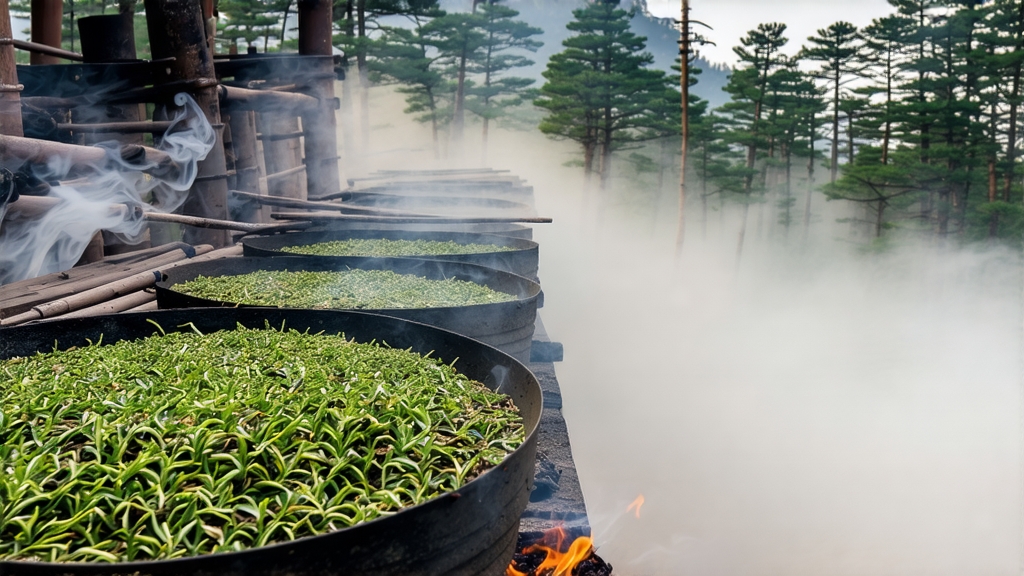
When European tea clippers first rounded the Cape of Good Hope in the early seventeenth century, the cargo that most excited London merchants was not silk or porcelain but a small, leathery leaf from the Wuyi Mountains of northern Fujian. That leaf—black, glossy, and perfumed with the unmistakable scent of pine resin—would become the first black tea the West ever tasted. The British called it “Bohea Souchong”; the Chinese knew it as Zheng Shan Xiao Zhong, today celebrated globally as Lapsang Souchong. In the intervening four centuries it has been imitated, adulterated, canonised and, more recently, reimagined by a new generation of growers who insist that the true, subtle smoke can only be coaxed from the original 1,200-metre-high terroir of Tongmu Guan, a protected enclave inside the Wuyi UNESCO World Heritage site.
History: From Ming Border Guards to Victorian Breakfast Cups
The origin story is inseparable from military urgency. Local lore claims that in 1567 a Ming garrison, rushing to dry freshly picked tea before bandits arrived, dried the leaves over green pine boughs. The accidental smoke infusion pleased the itinerant merchants who carried the tea north along the Tea Horse Road, and by 1604 Dutch traders were auctioning it in Amsterdam for twice the price of green tea. When Catherine of Braganza brought her tea habit to the English court in 1662, Lapsang Souchong was the status symbol she served. The East India Company’s ledgers from 1670 list “Souchon” as a separate grade above common Bohea, proof that smoke had already become value. By the nineteenth century the tea had mutated into two streams: the traditional pine-smoked leaf exported to Europe and Russia, and an increasingly delicate, unsmoked “Zheng Shan” reserved for Qing-dynasty scholars who believed smoke obscured the mountain’s mineral sweetness.
Micro-Terroir: Why Tongmu Guan Cannot Be Cloned
Tongmu Guan is a narrow gorge where the Chong’an River funnels cool, moist air between sheer granite cliffs. The mean annual temperature is 18 °C, humidity hovers at 85 %, and frequent fog filters sunlight to a soft, diffused glow. The soil is a stony, slightly acidic regolith rich in quartz and feldspar that drains instantly yet retains just enough moisture for the indigenous cultivar—Qizhong “peculiar variety”—to develop small, thick leaves unusually high in geraniol and linalool, the very volatiles that bond with pine smoke to create Lapsang’s signature apricot-and-turpene aroma. Chinese law now restricts tea bearing the name “Zheng Shan Xiao Zhong” to the 680-hectare core zone; leaves picked even five kilometres outside the gorge must be labelled “Wuyi black” and fetch a fraction of the price.
Leaf Grades and Styles
- Traditional Pine-Smoked Lapsang: The classic export style. After withering, leaves are pan-fired, rolled, then laid on bamboo trays suspended over smouldering Masson pine roots in a floor-level oven called a qinglou. The smoke is cool (35–40 °C) and resinous rather than acrid; one firing lasts eight hours and is repeated up to three times. The finished tea is glossy black with golden tips, the liquor a deep amber, the aroma a balanced triad of pine, longan fruit and malt.
- Unsmoked Zheng Shan: Developed for the domestic market in 1979, this version omits the final smoking stage. Instead, the leaf is gently baked over charcoal made from local hardwoods. The cup is lighter, honey-coloured, with notes of dried apricot, raw cacao and the “yan yun” (rock rhyme) minerality prized in Wuyi oolongs.
- Jin Jun Mei: A modern offshoot created in 2005 by Master Jiang Yuanxun. Only buds picked before Qingming are used; they are smoked for just thirty minutes to avoid masking the natural cocoa and floral character. Jin Jun Mei commands prices above USD 2,000 per kilogram and is often gifted at state banquets.
Craft: The Eight-Step Tongmu Ritual
- Plucking: One bud plus two leaves, 5–7 cm in length, harvested between 15 April and